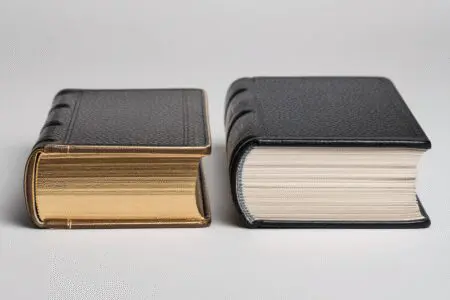Have you ever picked up a Bible, excited to connect with God’s Word, only to feel completely lost in a sea of “thees” and “thous”? If so, you are definitely not alone. For many people, the journey into Scripture can feel like trying to learn a new language. But what if I told you it doesn’t have to be that way? Finding the right translation can transform your Bible reading from a confusing chore into a life-giving joy. So, the big question is: Which version of the Bible is easiest to understand?
That’s exactly what we’re going to explore together. Think of this as a friendly chat over coffee, where we’ll walk through the different options available today. My goal isn’t to tell you which one is “best,” because that’s a personal choice. Instead, I want to give you the tools and information to find the version that speaks directly to your heart, making your time in God’s Word a conversation rather than a puzzle.
More in Bible Category
Which Bible Version Is the Best
Which Bible Translation Should I Read
What Is Wrong with the Amplified Bible
Key Takeaways
- Translation Philosophy Matters: Bibles are translated using different approaches. “Word-for-word” translations are very literal but can be hard to read. “Thought-for-thought” translations focus on conveying the original meaning in natural, modern language, making them much easier to understand.
- The NLT is a Top Choice for Readability: The New Living Translation (NLT) is widely considered one of the easiest versions to read, using contemporary English that flows smoothly.
- Other Easy-to-Read Options Exist: Versions like the New International Version (NIV), The Message (MSG), and the Good News Translation (GNT) are also excellent choices for those seeking clarity and understanding.
- Your Personal Preference is Key: The best Bible for you is the one you will actually read. Don’t be afraid to try a few different versions to see which one connects with you the most.
Why Are There So Many Different Bible Versions Anyway?
It’s a great question. Walking into a Christian bookstore can be overwhelming. You’ll see shelves lined with Bibles of all shapes, sizes, and acronyms: KJV, NKJV, NIV, ESV, NLT, CSB… the list goes on. Why all the variety?
The simple answer is that the Bible wasn’t originally written in English. The Old Testament was written primarily in Hebrew, and the New Testament was written in Greek. Translating ancient languages into modern English is a massive and complex task. Scholars have to make decisions about how to best capture the original meaning, and they don’t always agree on the perfect approach.
This leads to different “translation philosophies.” Imagine you’re trying to explain a foreign phrase to a friend. You could translate it word for word, which might sound awkward and clunky, or you could explain the overall meaning of the phrase, which would flow more naturally. Bible translators face this same choice.
What Is a “Word-for-Word” Translation?
Some Bible versions aim for a “word-for-word” (or formal equivalence) translation. The goal here is to stick as closely as possible to the structure and wording of the original Hebrew and Greek texts.
- Examples: King James Version (KJV), New King James Version (NKJV), English Standard Version (ESV), New American Standard Bible (NASB).
- Pros: These versions are excellent for deep, technical study because they preserve much of the original sentence structure.
- Cons: Because they follow ancient language patterns, they can be very difficult for a modern reader to understand. The language can feel stiff, and the meaning can sometimes get lost in the complex phrasing.
What Is a “Thought-for-Thought” Translation?
Other Bibles use a “thought-for-thought” (or dynamic equivalence) philosophy. Here, the primary goal is to translate the original meaning of the sentences and ideas into natural, modern English. The translators focus less on the exact word order and more on ensuring the message is clear and understandable to today’s reader.
- Examples: New Living Translation (NLT), New International Version (NIV), Good News Translation (GNT).
- Pros: These versions are much easier to read and understand. They flow like a contemporary book, making them perfect for daily reading, devotionals, and for those new to the Bible.
- Cons: Because the translators are interpreting the original thought, some of the nuances of the original language might be lost.
So, when we ask, “Which version of the Bible is easiest to understand?” we are almost always looking for a thought-for-thought translation.
So, Which Bible Version Is the Easiest to Read?
If you’re looking for the absolute easiest, most straightforward Bible to read in contemporary English, the New Living Translation (NLT) is often the top recommendation.
The NLT was created by a team of 90 Bible scholars with a clear goal: to produce a translation that is not only accurate to the original texts but also reads in a way that is powerful and clear for modern readers. It was specifically designed to be read aloud, so the sentences have a natural, conversational rhythm.
When you read the NLT, you’ll find that it communicates the message of Scripture in a warm, inviting way. It avoids archaic language and complicated sentence structures, making it incredibly accessible.
Let’s look at an example. Here is a well-loved verse, John 3:16, in a few different versions:
- King James Version (KJV): “For God so loved the world, that he gave his only begotten Son, that whosoever believeth in him should not perish, but have everlasting life.”
- New International Version (NIV): “For God so loved the world that he gave his one and only Son, that whoever believes in him shall not perish but have eternal life.”
- New Living Translation (NLT): “For this is how God loved the world: He gave his one and only Son, so that everyone who believes in him will not perish but have eternal life.”
Notice the subtle differences. The KJV uses “begotten” and “whosoever,” words we just don’t use anymore. The NIV is clearer. But the NLT’s phrasing, “For this is how God loved the world,” has a very direct and relational feel. It’s a small change, but those small changes throughout the entire Bible make the NLT exceptionally easy to connect with.
What Makes the New Living Translation (NLT) So Accessible?
- Modern Language: It uses vocabulary and grammar that are common today.
- Clear Sentence Structure: Sentences are generally shorter and more direct.
- Focus on Meaning: It prioritizes conveying the original message clearly over preserving the original word order.
- Emotional Warmth: The translation often carries a warm, pastoral tone that makes the text feel personal.
For someone just starting their journey with the Bible, or for anyone who has struggled with older translations, the NLT can feel like a breath of fresh air. It allows you to focus on what God is saying to you, not on deciphering complex language.
Are There Other Easy-to-Understand Bible Versions?
Absolutely! While the NLT is a fantastic starting point, several other versions are known for their readability. What works best for you might be different from someone else, so it’s great to know your options.
How Readable Is the New International Version (NIV)?
The New International Version (NIV) is perhaps the most popular Bible translation in the world today, and for good reason. It strikes a wonderful balance between a word-for-word and a thought-for-thought approach. Many people find it to be the “sweet spot” of translations.
The NIV is clear and easy to read, but it holds a bit closer to the original text structure than the NLT does. This makes it a great choice for both daily reading and for more serious study. If you find the NLT a little too informal, the NIV might be the perfect fit for you. It’s been trusted by churches, pastors, and readers for decades.
What About The Message (MSG) Bible?
You might have also heard of The Message (MSG). It’s important to understand that The Message is not a translation in the same way the NLT or NIV are. It’s a paraphrase.
The author, Eugene Peterson, was a pastor who wanted to bring the vitality and freshness of the original Greek and Hebrew into the language of the streets. He rephrased the entire Bible in his own words, using contemporary idioms and slang.
Here’s John 3:16 in The Message:
“This is how much God loved the world: He gave his Son, his one and only Son. And this is why: so that no one need be destroyed; by believing in him, anyone can have a whole and lasting life.”
The Message can be an incredible tool for seeing a familiar passage with fresh eyes. It can break open the meaning of a difficult verse in a powerful way. However, because it’s a paraphrase by one person, it’s generally recommended to use it alongside a more standard translation like the NLT or NIV, rather than as your primary Bible for study.
Is the Good News Translation (GNT) a Good Choice?
The Good News Translation (GNT), sometimes called the Good News Bible, is another excellent choice focused on readability. It was one of the first translations to use the dynamic equivalence (thought-for-thought) principle. It uses simple, everyday language and is often used in youth groups and for people learning English.
The GNT is known for its clarity and straightforwardness. It’s an excellent option if your main goal is to understand the basic story and message of the Bible without getting bogged down in complex vocabulary.
How Can I Choose the Right Bible for Me?
We’ve talked about a few great options, but how do you make the final decision? It really comes down to personal experience and connection. The best Bible for you is the one you will actually open and read regularly.
Here’s a simple plan to find your perfect fit:
- Go to a Bible Website: Websites like BibleGateway.com are fantastic resources. They allow you to look up any verse and compare dozens of translations side-by-side.
- Pick a Favorite Passage: Choose a Bible verse or a short chapter that you are familiar with and love. Maybe it’s Psalm 23, the Beatitudes in Matthew 5, or the “love is patient, love is kind” passage in 1 Corinthians 13.
- Read it in Different Versions: Read your chosen passage in the NLT, the NIV, The Message, and the GNT.
- Pay Attention to How You Feel: Which one sounds the most natural to you? Which one makes the meaning of the passage come alive in your heart? Which one makes you feel like God is speaking directly to you?
There is no right or wrong answer here. I know people who have read the KJV their whole lives and love its poetic beauty. I know others who felt like the Bible was a closed book until they discovered the NLT. God can speak through any translation. The goal is to remove the barriers that keep you from hearing His voice.
For those interested in the academic side of translation, learning about the process can be fascinating. You can explore resources from institutions like Dallas Theological Seminary, which offer deep insights into how scholars approach the monumental task of translating Scripture. For more, see their article on the topic at Dallas Theological Seminary’s website on Bible Translation.
Does an Easy-to-Read Bible Sacrifice Accuracy?
This is a common and important concern. Some people worry that if a Bible is too easy to read, it must have been “dumbed down” or that the translators have taken liberties with God’s Word.
It’s crucial to remember that readability and accuracy are not enemies. The teams of scholars who worked on versions like the NLT and NIV are world-class experts in the ancient languages. They have dedicated their lives to faithfully preserving the meaning of the original text.
Their approach recognizes that a translation isn’t accurate if no one can understand it. What good is a perfectly literal translation of a Greek idiom if it makes no sense to an English reader? True accuracy is about conveying the original author’s intended message. The translators of thought-for-thought versions argue that by putting the message into natural, understandable English, they are being more faithful to the purpose of Scripture, which is to reveal God to us.
Ultimately, having a Bible that you can read, understand, and apply to your life is what matters most. An easy-to-read version doesn’t weaken the Bible’s power; it unlocks it for more people. It invites you into the grand story of God’s love and redemption in a way that feels personal and real. So go ahead, find the version that speaks your language, and get ready to fall in love with God’s Word all over again.
Frequently Asked Questions – Which Version of the Bible Is Easiest to Understand

How should I choose the easiest Bible version for my needs?
To find the easiest Bible version, pray for guidance, test different versions by reading a familiar passage, consider your goal (study or daily reading), and remember that you can use multiple versions to gain a fuller understanding.
What is a paraphrase and is it the easiest version to read?
A paraphrase rewords the Bible into very modern and simple language, often retelling the story rather than translating the original text, making it very engaging and easy to understand, especially for newcomers or children, but less suitable for detailed study.
How does a ‘thought-for-thought’ translation differ from a literal one?
A ‘thought-for-thought’ translation prioritizes conveying the overall idea or message from the original text using modern, natural expressions, making it easier to read and ideal for daily devotion and general understanding.
What makes different Bible versions vary in readability?
Different Bible versions vary in readability because they are translated with different goals in mind; some focus on being very literal, translating closely to the original languages, while others aim to be easier to understand by focusing on the overall ideas and flow of the text.
What is a ‘word-for-word’ translation and who should use it?
A ‘word-for-word’ translation matches each Hebrew and Greek word with an English equivalent and preserves sentence style, making it suitable for deep study, as it reveals the structure and details of the original text, but it may be less smooth to read.




